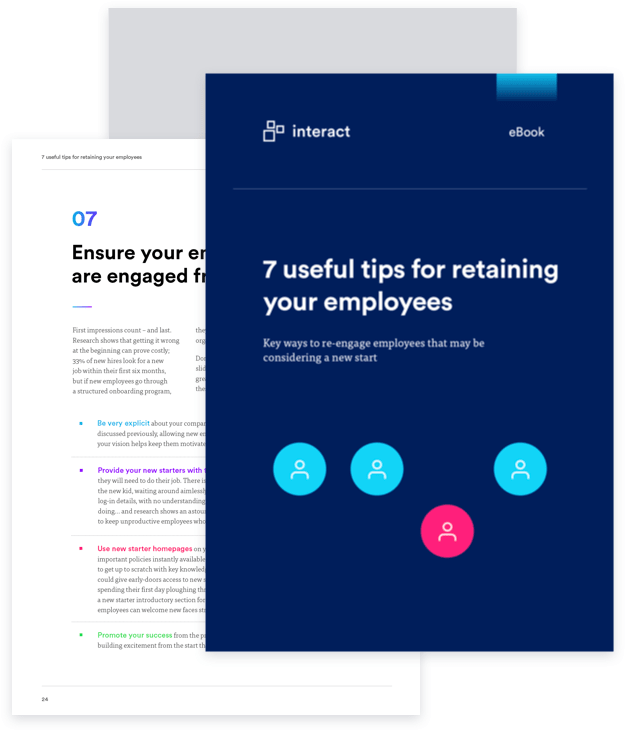Pre-boarding: the secret to employee engagement

When pre-boarding is a key component to successful recruiting, why are so many companies ignoring it?
Competition for today’s top talent is intense. If you’ve managed to find an outstanding candidate for a role at your company, there is no guarantee that they’ll turn up at reception on their first day. Nowadays, it’s an employee’s market. A rival firm can easily lure your perfect candidate away from you with promises of better culture, higher pay, and more opportunities. So how do you get your recruit to stick to their decision of joining your company?
Preboarding is the secret ingredient to successful recruiting that most businesses are ignoring. When a candidate lands a job, there will inevitably be a notice period to serve. This means that there is a minimum of a month that can go by before their start date, a very vulnerable time for the employer. Interest can wane, counteroffers can come in, and attention can be diverted – and it’s up to the new employer to make sure their chosen candidates stay faithful.
7 useful tips for retaining your employees
Which is where pre-boarding, a subset of onboarding, comes in. This is the period from offer acceptance to the new employee’s first day. The emphasis is on building excitement and enthusiasm for the role and presenting your organization in the best possible light.
Why should we pre-board?

Recruiting is a big enough job within an organization, and a lot of responsibility rests on the particular department in charge. Pre-boarding may create extra work but can save a lot of time, money, and resource overall. And there are several reasons why pre-boarding is seen as vital to the overall employee experience:
Piques enthusiasm: While the interview is a formalized process to assess the skills, talents, and suitability of the candidate, pre-boarding acts like positive PR for the company. This is the ideal opportunity to market your business to your new employee to build excitement. It should enable them to start their first day, feeling driven and motivated for their role.
Minimizes “ghosting”: Traditionally, employers were more likely to ‘ghost’ their candidates. Now, it’s the other way around and employees hold all the cards. While organizations have tightened up their hiring processes with phone calls, automated emails and letters, the rates for candidates not turning up on their first day has been calculated at around 2.4%
Curbs nerves: Nerves can be at an all-time high before beginning a new job, and the pre-boarding process can go some way to calming down first-day anxiety. It’s here that the starter learns what to expect, gets all the admin done and discovers a little a bit about the people they’re meeting.
Prepares the employee: 40% of staff turnover happens within the first month. So, organizations must make sure they use the period before the official start date to prep the employee and welcome them into the workforce family.
Gets the boring bits out of the way: The first day at work can be a whirlwind of forms, paperwork, and administration. This often distracts the employee from learning anything about the workplace and colleagues. To allow the starter to enjoy the first day, send over as much paperwork in the pre-boarding process as possible.
What does the preboarding process need to include?

In short, the pre-boarding process can include anything you think relevant for your new recruit to know. This could range from getting their uniform size and help working out their route to work, to a layout of the offices and a run-through of first day activities.
Your pre-boarding process will be unique to your organization and may change depending on the department your recruit is joining. However, there are some ideas that most organizations will find relevant and should include in the formation of their pre-boarding process.
Core values: Your core values sum your organization and its people. These are the essence of what you stand for, your beliefs, principles, and philosophies. They also provide a short cut for the recruit to understand what your vision and priorities are. Explaining these core values to your beginner will allow them to align themselves with your mission, and reinforces the relationship that they have with the organization.
7 useful tips for retaining your employees
Admin and forms: One of the most time-consuming, but necessary, parts of starting a new company is the administration involved. From tax forms to bank details and insurance documents, pre-boarding can be an excellent time to get the paperwork out of the way. That way, the first day can focus on other more exciting things.
Prep for the first day: Does your employee need to bring anything with them on the first day? Proof of ID? Insurance documents? Do you need them to start mid-morning? Make sure your pre-boarding contains all the information that your recruit needs so they can have everything prepared for their first day.
Map of office and local amenities: Information on the local area is another way to spur enthusiasm and excitement. Lists of the best places to get a coffee, go for after-work drinks and pick up lunch are a great introduction to their time at the company. And if you offer staff perks like gym discounts or reduced cinema tickets, even better.
Tips to prepare for your starter’s first day

There are a number of things to include in your pre-boarding process:
Office tour: Invite your new recruit on an office tour before they start employment at your organization. This will give them a chance to navigate where they will be working and allow them to meet the key people they will be interacting with on a daily basis. Office tours also act as a live organogram of the organization, demonstrating the various departments, managers, and key areas of the workplace.
Send intro video: This is used to great success by Zappos, who share their company culture with recruits as soon as they accept the job offer. This video gives an insight into what the new employee has in store and provides a refreshing welcome to the workplace from the comfort of the person’s own home.
Organize lunch: On your correspondence, invite your starter out to lunch. This can provide an informal setting for a catch-up and chat about work over some good food, and a great introduction to a good lunch spot near the office!
Send company swag: Sending out a little package of company swag is a great way to introduce your employee to your company. Whether it’s a hoodie, stationery, or other merchandise, it’s an excellent way to make an informal hello before their first day, and a great introduction to your company culture.
Invite to nearest social: If your workplace organizes socials, make sure you invite your new starter to the next one. These situations can be a great place for starters to meet their colleagues outside of the pressures of the workplace.
How your company intranet should play a part in pre-boarding

An intranet should play a significant part in pre-boarding. Limited access can be granted to new starters outside of the business. Using permission levels, you can display all the relevant information a new starter needs to know without compromising data. This can include welcome videos, core values, mandatory reads, and organization organograms.
Creating a preboarding section within the company intranet really demonstrates that the system has been thoroughly planned out, as well as an organization who is committed to providing a positive employee experience.
“Ninety-one percent of employees are retained in companies that have a formal onboarding program, but of those who don’t, just 50% are retained.”
Susan Vitale, chief marketing officer for iCIMS
Having offline workers doesn’t mean an intranet system is no longer relevant. In fact, offline workers often benefit more from the various aspects of the intranet – particularly in terms of communication and connection.
Preboarding is the ideal time to introduce your intranet to an employee – particularly if their line of work prevents them from connecting with colleagues on a daily basis. Here you can show them the value of accessing the intranet frequently, to keep in touch with company news, what colleagues are up to, benefits and perks, upcoming social events and other information that is relevant to the user.
The importance of effective pre-boarding
So, why should an organization focus so much on pre-boarding and onboarding? A lot of information points towards a direct correlation between the way the new starter is looked after in their first few weeks and employee turnover.
In fact, according to Susan Vitale, chief marketing officer for iCIMS, manufacturer of talent acquisition software, “Ninety-one percent of employees are retained in companies that have a formal onboarding program, but of those who don’t, just 50% are retained.”
The upshot of this? Apart from the disruption to the business, impact on colleagues, and delays in workflow and processes, the company takes a massive financial hit. While there is a whole mix of factors involved (hiring, onboarding, training, ramp time to peak productivity, the loss of engagement from others due to high turnover, higher business error rates, and general culture impacts), team members leaving in their first year is estimated to cost anything from 20% to three times the employee’s annual salary.
And a survey from Equifax Workforce Solutions, finds that if a new employee is going to quit, the chances are that it will happen within the first few months. The research discovered that 40% of turnover happens within the first month, and a further 10% or more leave before their first anniversary.
Staff churn is a massive concern to business, and the connection between the way an organization handles the first few weeks of an employee’s time at the business and overall retention rates, means that the concern should start as soon as the employer sends the official job offer to the candidate.
Providing all the information new employee requires, keeping in touch during their notice period, introducing them to the company culture and generally welcoming them to the organization can go a long way. The direct connection between effective onboarding and churn means that businesses need to pay attention to how it manages those delicate first few weeks and months of an employee’s career at the organization. And as demonstrated with pre-boarding, this begins well before the official first day.

